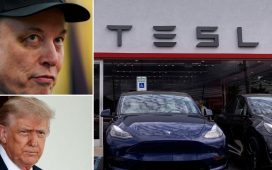00:00 Speaker A
Well, automakers led by Ford saw big sales gains in May, as price cuts and shedding inventories blunted the effect of President Trump’s auto tariffs. For more on the latest numbers and the state of the auto industry, let’s welcome in here Kevin Roberts, Car Gurus’s director of economic and market intelligence. Kevin, always good to see you. So, auto sales for May, Kevin, just looking, I mean, nice sales gains. I’m looking at Ford sales jumped about 16%, Kevin. Truck sales, strong, hybrid strong, EV not great. Toyota looks like an increase about 7% in May. We heard from Hyundai and Kia as well. Just broadly, when you looked over that data, Kevin, how would you characterize it? What would you make of it?
00:54 Kevin Roberts
Yeah, it was, uh, I would say a return to normal. So, uh, I like to say end of March, early April was kind of a crazy time for the auto industry when the tariffs were first announced. May was a little bit more back to normal, uh, traditionally a really strong kind of sales month for the industry. Um, you know, end of tax season, we have, uh, Memorial Day sales. So that’s been really kind of helpful for the industry. And you mentioned it, several automakers really had some strong months. Couple things I think really kind of helped there. Ford had their employee pricing for all, uh, you know, vehicle affordability has been a trend we’ve really been highlighting for a while now. So I think that kind of discounts really kind of helped drive sales there. And then you mentioned hybrids. That’s one that helped for both Ford and Toyota. Um, hybrid sales continue to see really strong growth. Consumers really like hybrids, and Ford and particularly Toyota are really dominant in hybrid power trains, which is helping to drive sales.
02:25 Speaker A
Do you think we saw some pull forward in those numbers too, though, Kevin? You know, folks trying to get ahead of tariffs?
02:37 Kevin Roberts
That is the million dollar question for the auto industry right now. Uh, how much, if if we did see pull ahead, how much did we see pull ahead? And where might that start to bite back? Um, you know, was that kind of Q2 sales towards the end of the quarter that we pulled that from, or was it later in the year? It’s really an unknown at this point. Uh, did we just kind of shake people off the sidelines who, you know, weren’t in the market, or did we kind of pull ahead a lot of volume, uh, in those kind of crazy weeks after the tariffs were announced? And it’s, it’s, it’s a major unknown for the industry right now.
03:31 Speaker A
Kevin, you know, tariffs in place. So do you think these automakers, do they maintain pricing, Kevin, or would you expect, no, starting here in June, perhaps, we’re, we’re going to see prices start rising?
03:51 Kevin Roberts
Yeah, so we’ve been monitoring what’s been happening to the average list price of vehicles on the site. Uh, somewhat surprising, we haven’t seen large shifts, uh, to this point. However, like you said, a lot of automakers I think we’re kind of in a wait and see approach after the tariffs were announced. And we’re starting to see a trickle of some announcements of, uh, price increases as we get into June. Uh, and that’s going to be a trend we kind of monitor, um, to see if that continues and if we start to see some of that expected price inflation, uh, for vehicles as we move into the second half of the year.
04:49 Speaker A
What did you make of the reaction in some names, um, this week, Kevin, for GM, for example, moving lower as Trump talked tough on steel tariffs?
05:07 Kevin Roberts
Yeah, so it, it’s a little bit of a different situation than if we would have talked a month or two ago. Uh, we had another executive order signed towards the end of April, uh, which gave hierarchy to stop stacking of a number of tariffs. And so that should stop, um, section 232 auto tariffs from being stacked with those steel and aluminum tariffs. So there is some protection for the auto industry. Now, it’s important to keep in mind that those, that kind of protection only exists for, uh, finished vehicles and parts covered in those tariffs specifically. So for parts not covered there, we could see an impact there. And I think that’s what you, that, uh, uh, that kind of risk is where you’re seeing that shift this week.
06:17 Speaker A
By the way, should kind of just see a breaking news headline here. Uh, according to the White House, UK steel tariffs, they’re going to remain at 25% for now. Um, lastly, Kevin, on Tesla, I want your views there. There, we did get some numbers this week. Broadly, weak sales for Tesla in Europe. What do you make of that, Kevin? Is that branding? Is that, you know, the Model Y change over? Is that more competition for Musk over there? Is it all three?
07:01 Kevin Roberts
So, uh, we, Tesla is a direct to consumer automaker, so we don’t get their data in, in our listing data, so a little bit difficult to say there. What I can say from the used side of the market, even with all the noise around Tesla recently, still, uh, still seems pretty strong, uh, demand for used Teslas out in the marketplace. So can’t, can’t comment as much on the new side of the market, but used side still sees, uh, uh, strong interest for used Teslas.
07:48 Speaker A
Interesting. Kevin, always great to have you on the show. Thanks so much for your time.
07:54 Kevin Roberts
My pleasure.









